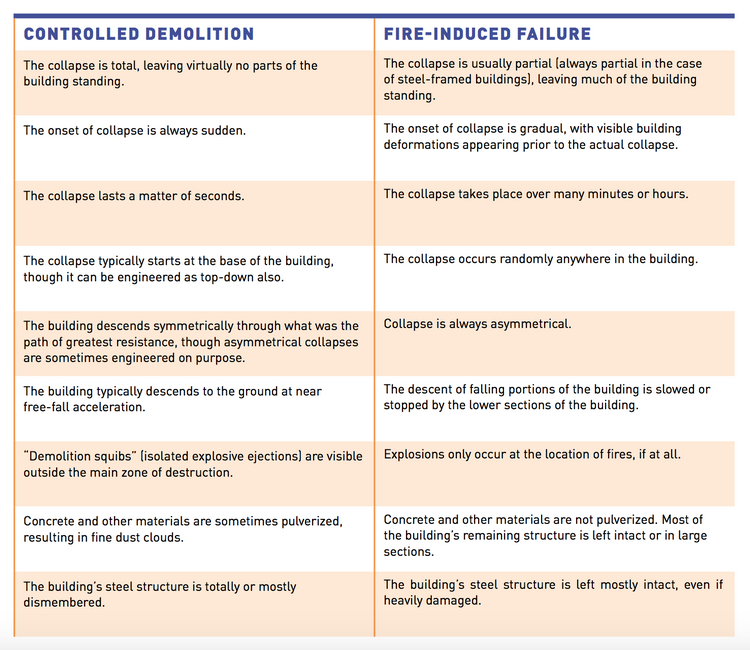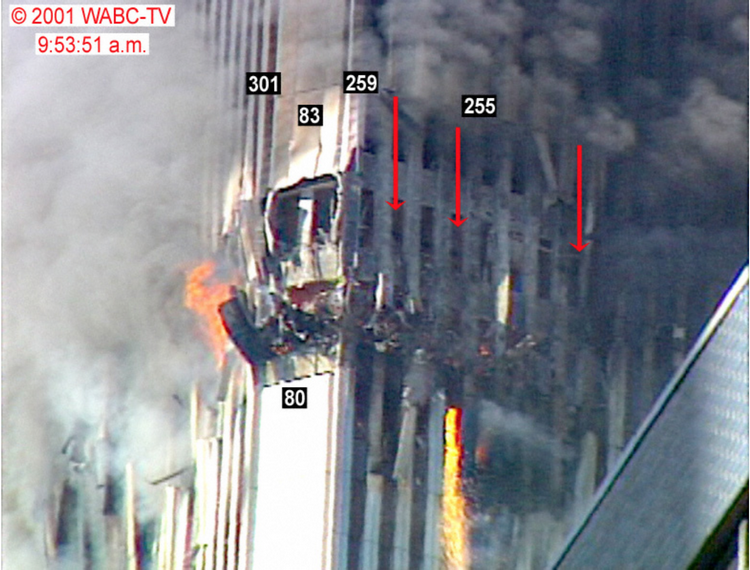Editor’s Note: The following article by AE911Truth’s director of strategy and development, Ted Walter, was published in the monthly Norwegian newspaper Ny Tid on September 14, 2017. The article elicited a frenzied reaction from much of Norway’s mainstream media, eventually culminating in daily newspaper Klassekampen severing its agreement with Ny Tid to include the monthly newspaper in its distribution. In response to the controversy, Ny Tid invited Norway-based mechanical engineer and AE911Truth petition-signer David Llewelyn to write an article for the October issue. Walter’s article is reprinted below in English with Ny Tid's permission. Llewelyn’s article, also reprinted in English with Ny Tid's permission, can be read here.
One day in the summer of 2016, five years after leaving his job at the U.S. Commerce Department’s National Institute of Standards and Technology (NIST), Peter Michael Ketcham began reading the reports his former agency had published about the collapse of the three World Trade Center towers on September 11, 2001.
Ketcham, a mathematician and scientific computing expert, had not participated in NIST’s six-year-long investigation, nor had he paid it much attention. His sudden interest, years after the fact, was sparked by a conversation with a close friend, who told Ketcham there was “growing evidence” that the official narrative of 9/11 might not be true.
“In a very short amount of time,” Ketcham recounts in Stand for the Truth — a documentary that I produced and that my organization, Architects & Engineers for 9/11 Truth (AE911Truth), released earlier this year — it became clear to him that NIST’s investigation of the disaster “was not a sincere and genuine study.”
Ketcham was astonished to find that NIST had done “everything they could” to avoid what he now realized was “the most likely hypothesis” — namely, that all three towers were brought down by controlled demolition. “This was not a case of some subtle differences, subtle discrepancies, or differences of scientific opinion that needed further investigation,” Ketcham remarks in the film. “This was glaring. Glaring, clear-cut.”
“Glaring” and “clear-cut” are strong words coming from a man who conducted scientific research at NIST for fourteen years — especially when one considers the backdrop of unending “debate” over the cause of the World Trade Center’s destruction, a debate that has lasted more than a decade and a half.
As civil engineer Jonathan Cole and physicist Timothy Eastman observe in their 2013 literature review on the subject, “What is most striking about our results is the fact that there is serious disagreement as to how the WTC structures fell on September 11, 2001. . . . At this point, almost 12 years later, there should not be any significant disagreement about such a fundamental issue. . . .”
Before I propose an explanation for why this most unusual of scientific debates rages on, I will first summarize the “glaring” and “clear-cut” evidence that Ketcham discovered when he began doing his research one year ago.
Prior to September 11, 2001, no steel-framed high-rise had ever collapsed completely due to fire. This is an established fact that everyone agrees on.
Thus, the official narrative contends that this unprecedented phenomenon occurred three times in one day, starting with the rapid and explosive destruction of the 110-story Twin Towers 29 minutes apart, followed nearly seven hours later by the smooth, symmetrical fall of the 47-story World Trade Center Building 7 (WTC 7) — which was not struck by an airplane — straight into its footprint at free-fall acceleration. If you haven’t seen the collapse of WTC 7, I encourage to Google it right now.
As we document in AE911Truth’s 50-page booklet Beyond Misinformation, controlled demolitions and fire-induced collapses have essentially the opposite features. For example, in controlled demolitions, the fall of the structure is always symmetrical (or designed to move in a specific direction). In fire-induced collapses, the collapse is always asymmetrical.
 Table 1 from Beyond Misinformation compares the features of controlled demolition and fire-induced collapse.
Table 1 from Beyond Misinformation compares the features of controlled demolition and fire-induced collapse.
On 9/11, the collapses of the Twin Towers exhibited all but one feature of controlled demolition — namely, instead of starting from the base of each tower, they began at the upper floors — while the collapse of WTC 7 exhibited every feature of controlled demolition. Therefore, in effect, the official narrative contends not only that the Twin Towers and WTC 7 were the first steel-framed high-rises ever to collapse due to fire but that they were the first fire-induced collapses ever to exhibit nearly every feature of controlled demolition.
Scientists are not supposed to posit unprecedented causes to explain familiar occurrences, absent some kind of extraordinary evidence. Thus, any unbiased investigator who was following the principles of science-based investigation would have made controlled demolition his or her primary hypothesis.
As it happens, it was not uncommon in those first few days following 9/11 to wonder if the buildings had been intentionally demolished. Many people — investigators, first responders, news reporters, and even some Bush administration officials — suspected right away that the destruction they had witnessed was caused by pre-placed explosives. For example, Ronald Hamburger, a structural engineer who would go on to be a member of the first official WTC investigation, remarked to the Wall Street Journal on September 19, 2001, “‘It appeared to me that charges had been placed in the building.’ . . . Upon learning that no bombs had been detonated, ‘I was very surprised.’”
Meanwhile, although the collapse of WTC 7 escaped the attention of most of the world, reporters on the scene noted its obvious similarity to a classic controlled demolition. “I turned in time to see what looked like a skyscraper implosion,” said 1010 Wins reporter Al Jones. “It looked like it had been done by a demolition crew, the whole thing just collapsing down on itself.” “It was almost as if it were a planned implosion,” uttered a bewildered Vince DeMentri on CBS 2. “It just pancaked.”
But engineers dispatched by the American Society of Civil Engineers and the Federal Emergency Management Agency (FEMA) either ignored the possibility of controlled demolition or never considered it. Ronald Hamburger, the FEMA investigation team member who is quoted above, best exemplifies this textbook case of “expectation bias.” Because the FEMA investigation was barely underway by the date Hamburger was quoted in the Wall Street Journal — September 19th — the only way he could have “learned” that no bombs had been detonated was from the official narrative. Thus, without having conducted any investigation, he abandoned his initial hypothesis and concluded that fires were to blame.
If Hamburger and his fellow investigators had actually interviewed the hundreds of first responders who had survived the disaster, they would have found ample eyewitness evidence suggesting that “bombs” — or, more accurately, “explosives” — had been detonated. Between October 2001 and January 2002, the Fire Department of New York (FDNY) conducted interviews with 503 of its members. Graeme MacQueen, a retired professor of Religious Studies, did a methodical analysis of these World Trade Center Task Force Interviews and found that 118 out of the 503 FDNY personnel described phenomena they consciously perceived as being explosions. Adding to those interviews the statements of numerous other eyewitnesses, MacQueen came up with a total of 156 documented witnesses to explosions.
If you don’t have time to read all 156 eyewitness accounts, I suggest the vivid description of explosions given by FDNY Captain Karin DeShore: “[T]here was this orange and red flash coming out. Initially it was just one flash. Then this flash just kept popping all the way around the building and that building had started to explode. The popping sound, and with each popping sound it was initially an orange and then red flash came out of the building and then it would just go all around the building on both sides as far as I could see. These popping sounds and the explosions were getting bigger, going both up and down and then all around the building.”
Not surprisingly, the FEMA report, published in May 2002, doesn’t include a single eyewitness account of the collapses. NIST, which inherited the mantle of explaining the WTC collapses after the FEMA report was published, at first denied there was any evidence of explosions. When confronted with the fact that 118 members of the FDNY testified to witnessing explosions, NIST wrote, “Taken as a whole, the interviews did not support the contention that explosives played a role in the collapse of the WTC Towers.”
MacQueen roundly rejects NIST’s logic. “We have 118 witnesses out of a pool of 503,” he notes. “Over 23 percent of our group are explosion witnesses. In my judgment, this is a very high percentage of witnesses, especially when we consider . . . [that interviewees] were typically not asked about explosions, and, in most cases, were not even asked about the collapses of the towers. What testimony we have was volunteered, and it therefore represents not the maximum number of witnesses to explosions but the minimum number.”
After gathering eyewitness testimony, an unbiased investigator then would have done a forensic examination of the debris. Unfortunately, that task was impossible to carry out, because the City of New York swiftly removed the steel from the World Trade Center site and sold virtually all of it for recycling before investigators could inspect it.
Even though a little steel was set aside, NIST refused to run simple lab tests on it for residues of explosives or incendiaries. Later, NIST proffered the deeply unscientific rationale that such analysis “would not necessarily have been conclusive.” Needless to say, never would the possibility of a test being inconclusive stop a genuine scientist from conducting that test.
Fortunately, there is still a significant amount of publicly available forensic evidence that independent 9/11 researchers have been able to study, and this evidence, it turns out, is the most impossible for the official narrative to explain.
For one, there was the yellowish/orangish molten metal seen pouring out of the South Tower continuously for the seven minutes prior to its collapse. Because the melting point of structural steel is around 1,482°C and because the hottest that NIST alleges the fires reached in the Twin Towers was 1,100°C, NIST had to conjure up a creative explanation for this stream of molten metal. So NIST posited that the substance “could have been molten aluminum,” which has a lower melting point than steel.
 Molten metal is seen pouring out of the South Tower near the bottom center of the frame.
Molten metal is seen pouring out of the South Tower near the bottom center of the frame.
The trouble is, molten aluminum has a silvery — not a yellowish/orangish — appearance. Having backed itself into a corner, NIST later asserted that the silvery molten aluminum turned yellowish/orangish because it was “very likely mixed with large amounts of hot, partially burned solid organic materials. . . .”
Predictably, NIST did not bother to test that hypothesis. Unfortunately for NIST, though, physicist Steven Jones did. In his experiment, he discovered that mixing organic materials with molten aluminum “did not alter the silvery appearance of the flowing, falling aluminum.”
While forced to acknowledge that molten metal had in fact poured out of the South Tower — after all, it couldn’t wish away the images captured in numerous photographs and videos — NIST refused to acknowledge the molten metal that dozens of eyewitnesses observed throughout the debris. The closest NIST came to admitting this evidence was when it made the patently false assertion that “[a]ny molten steel in the wreckage was more likely due to the high temperature resulting from long exposure to combustion within the pile than to short exposure to fires or explosions while the buildings were standing.” This claim could not be more blatantly wrong, as it is simply impossible for a diffuse hydrocarbon fire to reach temperatures close to the 1,482°C required to melt steel, particularly in an oxygen-starved debris pile.
The most obvious explanation for the molten metal — namely, that some form of an incendiary called “thermite” was used to sever the towers’ columns — was corroborated years later, when a team of scientists discovered unreacted nano-thermite in four independent samples of WTC dust. Nano-thermite is a form of thermite with explosive properties engineered at the nano-level in places like Lawrence Livermore National Laboratory. There is no reason for this substance to have been found in the World Trade Center dust — that is, no reason other than that it was used to destroy all three structures.
Then there is the startling statement from the buildings’ owner, Larry Silverstein, who infamously said of WTC 7 in a 2002 PBS documentary, “I remember getting a call from the fire department commander telling me that they were not sure they were gonna be able to contain the fire. I said, ‘You know, we’ve had such a terrible loss of life, maybe the smartest thing to do is pull it.’ And they made that decision to pull and we watched the building collapse.”
Silverstein later claimed that when he used the term “pull it,” he meant to evacuate firefighters from the building. Other accounts, however, support the interpretation that he meant to demolish the building. For example, FOX News reporter Jeffrey Scott Shapiro wrote in 2010, Shortly before the building collapsed, several NYPD officers and Con-Edison workers told me that Larry Silverstein . . . was on the phone with his insurance carrier to see if they would authorize the controlled demolition of the building. . . .” Speaking to MSNBC minutes after the collapse, FDNY Lieutenant David Restuccio confirmed, “We had heard reports that the building was unstable, and that eventually it would either come down on its own, or it would be taken down.”
But perhaps the most damning evidence of all is the total absence of evidence that fires had anything to do with the collapses and the resulting failure of NIST to construct a complete and plausible hypothesis.
In the case of the Twin Towers, NIST arbitrarily stopped its analysis at the point of collapse initiation, asserting that global collapse was inevitable once the upper section of each tower lost support and began to fall. When pressed on this matter, NIST conceded that it was “unable to provide a full explanation of the total collapse.” The article “Some Misunderstandings Related to the WTC Collapse Analysis,” published in the International Journal of Protective Structures in 2013, helps us understand why NIST was “unable to provide a full explanation.” It demonstrates mathematically that the fall of the upper section would have been stopped within one to two stories in the absence of explosives.
In the case of WTC 7, NIST neglected to produce any analysis substantiating the initiating event that it alleges triggered the collapse of the entire structure. NIST also omitted key structural features of the building from its computer model — features that, when included, render NIST’s “probable collapse sequence” indisputably impossible.
NIST’s fundamental failure to construct a complete and plausible hypothesis brings us back to the question of why this most unusual of scientific debates lives on sixteen years later. The reality is that, rather than being a scientific debate, it is a political battle being waged to determine the public narrative of the most pivotal event of the 21st century.
On one side of this battle is “glaring” and “clear-cut” evidence. On the other side is an official narrative based on scientific fraud. It survives only because of the concerted efforts of a few to conceal the truth, the inability of many to accept the magnitude of deceit, and the reluctance of some who know the truth to speak out.
Let us hope that as we move further away from this traumatizing event, more people like Peter Ketcham will have the courage to rethink what they once believed and the moral compulsion to do something about it.
Ted Walter is the director of strategy and development for Architects & Engineers for 9/11 Truth (AE911Truth). In 2015, he authored AE911Truth’s Beyond Misinformation: What Science Says About the Destruction of World Trade Center Buildings 1, 2, and 7, and in 2016, he authored AE911Truth’s World Trade Center Physics: Why Constant Acceleration Disproves Progressive Collapse. He holds a Master of Public Policy degree from the University of California, Berkeley.




